A) is 2.
B) is 3.
C) is 4.
D) cannot be determined from the information given.
F) A) and C)
Correct Answer

verified
Correct Answer
verified
Multiple Choice
The department of finance estimates that the actual multiplier in Canada ranges from:
A) 0.1 to 1.6.
B) 0.4 to 2.1.
C) 0.7 to 3.4.
D) 0.2 to 0.9.
F) B) and C)
Correct Answer

verified
Correct Answer
verified
Multiple Choice
If the marginal propensity to consume is.9, then the marginal propensity to save must be:
A) 1
B) .1.
C) 1.1.
D) .9.
F) None of the above
Correct Answer

verified
Correct Answer
verified
Multiple Choice
Suppose an economy's consumption schedule shifts from C1to C2as shown in the diagram below.We can say that its: 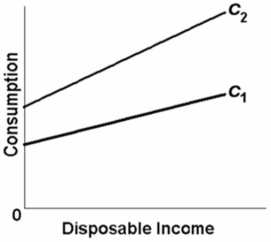
A) MPC has increased but its APC at each income level is unchanged.
B) APC at each income level is increased but its MPC is unchanged.
C) MPC and APC at each income level have both increased.
D) MPC and APC at each income level have both decreased.
F) None of the above
Correct Answer

verified
Correct Answer
verified
True/False
1 - MPC = MPS.
B) False
Correct Answer

verified
Correct Answer
verified
Multiple Choice
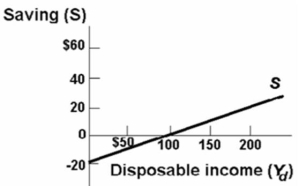 Refer to the above diagram.The break-even level of disposable income:
Refer to the above diagram.The break-even level of disposable income:
A) is zero.
B) is minus $10.
C) is $100.
D) cannot be determined from the information given.
F) B) and D)
Correct Answer

verified
Correct Answer
verified
Multiple Choice
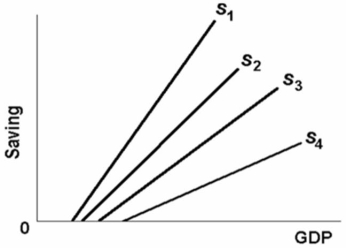 The above figure shows the saving schedules for economies 1, 2, 3, and 4.Which economy has the highest marginal propensity to consume?
The above figure shows the saving schedules for economies 1, 2, 3, and 4.Which economy has the highest marginal propensity to consume?
A) 1
B) 2
C) 3
D) 4
F) B) and D)
Correct Answer

verified
Correct Answer
verified
Multiple Choice
Which of the following is a non-income factor affecting consumption?
A) Wealth
B) Real interest rates
C) Borrowing
D) All the answer choices are correct.
F) None of the above
Correct Answer

verified
Correct Answer
verified
Multiple Choice
An upward shift of the saving schedule suggests:
A) nothing with respect to changes in the APC and APS.
B) that the APC and APS have both decreased at each GDP level.
C) that the APC and APS have both increased at each GDP level.
D) that the APC has decreased and the APS has increased at each GDP level.
F) B) and D)
Correct Answer

verified
Correct Answer
verified
True/False
The slope of the consumption schedule is measured by the MPC.
B) False
Correct Answer

verified
Correct Answer
verified
Multiple Choice
Which one of the following will cause a movement up along an economy's saving schedule?
A) an increase in household debt outstanding
B) an increase in disposable income
C) an increase in stock prices
D) an increase in interest rates
F) A) and C)
Correct Answer

verified
Correct Answer
verified
Multiple Choice
Which of the following countries had the lowest gross investment expenditure as a percentage of GDP in 2014, as per Image 10.2 Global Perspective?
A) China
B) Korea
C) Canada
D) United States
F) B) and C)
Correct Answer

verified
Correct Answer
verified
Multiple Choice
The investment demand curve of an economy is:
A) downward sloping.
B) upward sloping.
C) horizontal.
D) vertical.
F) None of the above
Correct Answer

verified
Correct Answer
verified
Multiple Choice
The simple multiplier:
A) occurs only in response to a change in the level of investment spending.
B) can be found by taking the reciprocal of the MPS.
C) occurs only when intended investment increases as GDP increases.
D) is measured by the slope of the saving schedule.
F) A) and B)
Correct Answer

verified
Correct Answer
verified
True/False
The average propensity to consume can be defined as income divided by consumption.
B) False
Correct Answer

verified
Correct Answer
verified
Multiple Choice
The saving schedule is drawn on the assumption that as income increases:
A) saving will decline absolutely and as a percentage of income.
B) saving will increase absolutely, but remain constant as a percentage of income.
C) saving will increase absolutely, but decline as a percentage of income.
D) saving will increase absolutely and as a percentage of income.
F) A) and D)
Correct Answer

verified
Correct Answer
verified
Multiple Choice
If the MPC is .8 and the disposable income is $200, then
A) consumption and saving cannot be determined from the information given.
B) saving will be $20.
C) personal consumption expenditures will be $80.
D) saving will be $40.
F) A) and C)
Correct Answer

verified
Correct Answer
verified
Multiple Choice
The greater is the marginal propensity to consume:
A) the smaller is the marginal propensity to save.
B) the higher is the interest rate.
C) the lower is the average propensity to consume.
D) the lower is the price level.
F) A) and C)
Correct Answer

verified
Correct Answer
verified
Multiple Choice
Refer to the diagram given below. 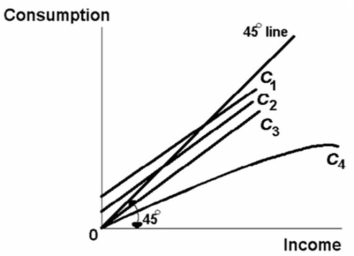 The diagram given above shows consumption schedules.As income rises, the marginal propensity to consume remains constant for:
The diagram given above shows consumption schedules.As income rises, the marginal propensity to consume remains constant for:
A) none of the consumption schedules.
B) only C3.
C) only C1, C2, and C3.
D) only C4.
F) A) and D)
Correct Answer

verified
Correct Answer
verified
Multiple Choice
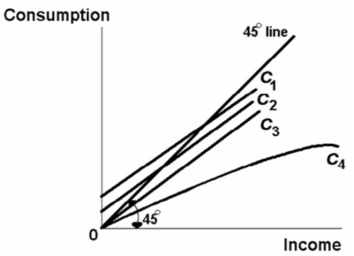 Refer to the above diagram.The APC diminishes as income increases for:
Refer to the above diagram.The APC diminishes as income increases for:
A) none of the consumption schedules shown.
B) C3 only.
C) C1, and C2.
D) C4 only.
F) C) and D)
Correct Answer

verified
Correct Answer
verified
Showing 181 - 200 of 200
Related Exams